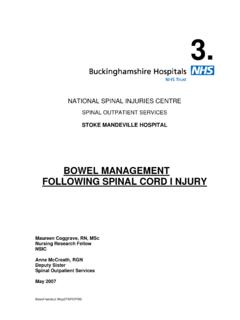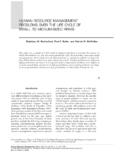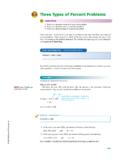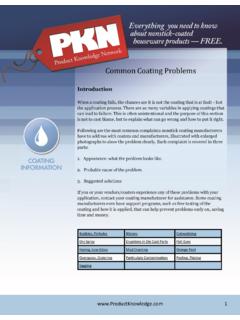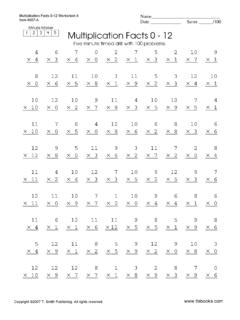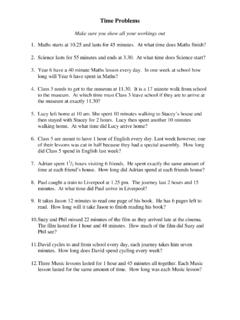Transcription of 2843R Ear problems 12/5/09 12:07 Page 1 ear health
1 2843R Ear problems 12/5/09 12:07 Page 1. Ears and ear health How to look after your ears and cope with tinnitus, dizziness and balance problems 2843R Ear problems 12/5/09 12:07 Page 2. Ears and ear health We're RNID, the charity working to create a world where deafness or hearing loss do not limit or determine opportunity, and where people value their hearing. 2843R Ear problems 12/5/09 12:07 Page 3. Ears and ear health You should read this leaflet if you want to know about: how your ears work common problems that affect your ears or hearing balance problems tinnitus (noises in the ear or head). how to look after your ears. If you are at all worried about your hearing or balance, you should see your GP. 3. 2843R Ear problems 12/5/09 12:07 Page 4.
2 Ears and ear health How your ears work Ears are your organs of hearing and balance. As you can see from the illustration on pages 6-7, our ears have three sections: the outer ear the middle ear the inner ear. Sounds enter our outer ear (the pinna and external ear canal) and travel down the ear canal until they reach our eardrum. Once the sound reaches our eardrum, it vibrates, and is passed into the middle ear. Our middle ear is an air-filled cavity that links the outer ear with the inner ear. It is also connected to the back of the throat by a small passage called the Eustachian tube. Within the middle ear there are three tiny bones stretching from the eardrum to the cochlea (our hearing organ within the inner ear).
3 It is these three bones that mechanically conduct the soundwave through the middle ear to the inner ear. The inner ear has two parts: the cochlea, responsible for hearing the vestibular system, responsible for balance. The cochlea is a fluid-filled chamber that looks a bit like a snail shell. When the sound vibrations enter the cochlea, the fluid moves and hair-like sensory cells trigger an electrical pulse in the auditory nerve. Different hair cells pick up different frequencies of sound depending on where they are positioned in the cochlea. The auditory nerve then passes electrical impulses to your brain, which recognises them as sound. The vestibular system is also filled with fluid and has three small sections.
4 Each of these sections detects head movement in a different direction. When you move your head, the fluid within these sections moves. In a similar way to the hair-like cells in the cochlea, they turn the mechanical movement into an electrical signal and send the information to your brain. This information is used with your vision and sensors in your joints to help you maintain your balance. 4. 2843R Ear problems 12/5/09 12:07 Page 5. Ears and ear health Common ear problems In the outer ear Blockages in the external ear canal may affect your hearing. They are usually caused by wax. Your ear makes wax in order to clean itself. The wax normally comes out of the ear on its own. If it builds up too much, it can cause a blockage and you may need to visit your GP to have it removed.
5 Don't try to remove wax from your ears yourself. Never push cotton buds, fingers or anything else into your ears, as you could push any wax there is onto your eardrum. This could cause pain, infection and deafness. Ask your GP to check your ears if you think wax has built up. See page 15 for more information. Otitis externa Otitis externa is when the skin of the ear canal becomes inflamed. This may happen if you have scratched your ear or if you have a skin condition such as eczema. Otitis externa may be painful and give you a watery discharge. There is usually little or no hearing loss. See your GP to get ear drops and try not to get your ear wet or scratch it. Exostosis Exostosis is an abnormal bone growth in the ear canal.
6 It's the body's way of protecting the ear drum from cold water and wind caused by frequent exposure to it. It's often found in surfers and will progressively get worse over the years with continual exposure. It can eventually cause infections, pain and hearing loss. 5. 2843R Ear problems 12/5/09 12:07 Page 6. Ears and ear health The ear The ossicles: Malleus (hammer). Incus (anvil). Ear canal: Inflammation of the ear canal is called otitis externa. This and other problems , such as eczema or too much wax, may need treatment from a GP. Pinna Hairs Outer ear Middle ear Inner ear 2783/0407 Illustration Willie Ryan 6. 2843R Ear problems 12/5/09 12:07 Page 7. Ears and ear health Stapes (stirrup): Vestibular system: The stapes fits into the problems here may cause oval window.
7 If the stapes vertigo (dizziness). becomes fixed, this is called otosclerosis. Vestibular nerve and auditory nerve: These lead to your brain. Occasionally, a tumour here called an acoustic neuroma can cause sensorineural deafness. Cochlea: Damage here, caused by noise or ageing, also results in sensorineural deafness (see page 10). Oval window Round window The eardrum or Eustachian tube: tympanic membrane If this stops opening, the aid pressure is not equal in both sides of the eardrum. This can cause the eardrum to become retracted and lead to earache. The middle ear can then fill with fluid, which can affect your hearing. 7. 2843R Ear problems 12/5/09 12:07 Page 8. Ears and ear health Common ear problems In the middle ear Otitis media Otitis media is an infection or inflammation of the middle ear usually caused by a viral or bacterial infection.
8 This can stop the eustachian tube from opening as it should, preventing air from reaching the middle ear. When this happens, the middle ear can fill up with fluid that can become thick, like glue. This problem is called glue ear or otitis media with effusion. The build-up of fluid in the middle ear reduces the movement of the eardrum and ossicles, and so causes a loss of hearing. The changes in pressure caused by the build-up of fluid can be painful. Because children have smaller, more horizontal eustachian tubes they're more likely than adults to get glue ear. Most will get better without treatment and their hearing will return to normal. But get advice from your GP in any case. If your child has glue ear and it does not get better, an ENT (ear, nose and throat) surgeon may recommend an operation called a myringotomy where a tiny ventilation tube called a grommet is inserted temporarily into the eardrum.
9 This allows air into the middle ear and prevents a build- up of fluid. For more information, see our factsheet Glue ear. 8. 2843R Ear problems 12/5/09 12:07 Page 9. Ears and ear health Otosclerosis Otosclerosis affects more women than men. It can run in families and often begins around the age of 30. It is caused by a bony overgrowth of the stapes one of the three tiny bones (ossicles). that stretch across the middle ear. The stapes becomes rigid and sound vibrations cannot pass freely through the ossicles. If otosclerosis is not treated, it will continue to worsen and affect hearing more severely. Hearing aids are very useful if you have otosclerosis. Most people can have an operation a stapedectomy or stapedotomy.
10 A tiny piston replaces the stapes so that sound can travel to the inner ear. This operation has a high success rate. For more information, see our factsheet Middle ear conditions. Damaged ossicles The ossicles are tiny bones in the middle ear. Serious infections and head injuries can damage them, and occasionally babies are born with malformed ossicles. Ossicles can be repaired or replaced by having an operation called an ossiculoplasty. Perforated eardrums Perforated eardrums can be caused by untreated otitis media, other serious ear infections, head injuries, explosions, or poking things in your ear. They normally heal by themselves and any hearing loss is only temporary. More serious damage can be treated by an operation called a myringoplasty, where a tissue graft is used to seal up the hole.
